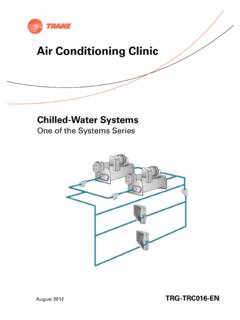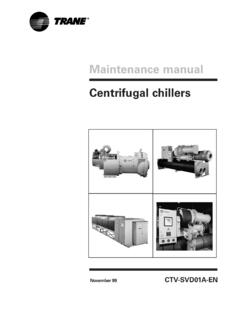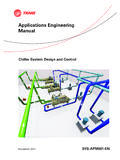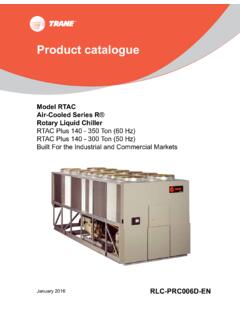Transcription of Absorption Water Chillers
1 Air Conditioning Clinic Absorption Water Chillers One of the Equipment Series July 2012 TRG-TRC011-EN. Absorption Water Chillers One of the Equipment Series A publication of Trane Preface Absorption Water Chillers A Trane Air Conditioning Clinic Figure 1. Trane believes that it is incumbent on manufacturers to serve the industry by regularly disseminating information gathered through laboratory research, testing programs, and field experience. The Trane Air Conditioning Clinic series is one means of knowledge sharing. It is intended to acquaint a nontechnical audience with various fundamental aspects of heating, ventilating, and air conditioning. We have taken special care to make the clinic as uncommercial and straightforward as possible.
2 Illustrations of Trane products only appear in cases where they help convey the message contained in the accompanying text. This particular clinic introduces the concept of Absorption Water Chillers . 2000 Trane All rights reserved ii TRG-TRC011-EN. Contents Introduction .. 1. period one Absorption Refrigeration Cycle .. 3. Absorption System Fluids .. 6. Components of the Absorption Cycle .. 8. Equilibrium Chart .. 15. period two Absorption chiller Types .. 18. Single-Effect chiller .. 19. Double-Effect chiller .. 21. Direct-Fired chiller .. 27. chiller /Heater .. 30. period three Capacity Control .. 34. Crystallization .. 37. Purge System .. 44. period four Maintenance Considerations.
3 46. period five Application Considerations .. 53. Cooling- Water Temperature Limitations .. 54. Combination chiller Plants .. 55. Special Considerations for Direct-Fired Chillers .. 57. Equipment Rating Standards .. 59. period six Review .. 60. Quiz .. 65. Answers .. 68. Glossary .. 69. TRG-TRC011-EN iii iv TRG-TRC011-EN. Introduction notes Chilled- Water System Figure 2. Water Chillers are used in a variety of air conditioning and process cooling applications. They are used to make cold Water that can be transported throughout a facility using pumps and pipes. This cold Water can be passed through the tubes of coils to cool the air in an air conditioning application, or it can provide cooling for a manufacturing or industrial process.
4 Systems that employ Water Chillers are commonly called chilled- Water systems. Absorption centrifugal helical - rotary Figure 3. Although Water Chillers come in many sizes and types, they all produce cooling using the same basic principles of heat transfer and change-of-phase of the refrigerant. This is accomplished by the chiller refrigeration cycle. They differ from each other based on the refrigeration cycle and the type of refrigerant fluid used. TRG-TRC011-EN 1. Introduction notes Water Chillers using the vapor-compression refrigeration cycle vary by the type of compressor used. The compressor works to draw in refrigerant vapor and increase its pressure and temperature to create the cooling effect.
5 Reciprocating, scroll, helical - rotary (or screw), or centrifugal compressors are generally used in Water Chillers that employ the vapor-compression refrigeration cycle. Absorption Water Chillers make use of the Absorption refrigeration cycle and do not use a mechanical compressor. The Absorption refrigeration cycle is used in both small and large air-conditioning equipment. This clinic, however, focuses on large Water - chiller applications of the Absorption cycle. The different types of Absorption Water Chillers will be discussed in detail in Period Two. 2 TRG-TRC011-EN. period one Absorption Refrigeration Cycle notes Absorption Water Chillers period one Absorption Refrigeration Cycle Figure 4.
6 This period describes the components of the Absorption refrigeration cycle. Comparing the Absorption refrigeration cycle with the more familiar vapor- compression refrigeration cycle is often an easy way to introduce it. Like the vapor-compression refrigeration cycle, the Absorption refrigeration cycle uses the principles of heat transfer and change-of-phase of the refrigerant to produce the refrigeration effect. Both the vapor-compression and Absorption refrigeration cycles accomplish cooling by absorbing heat from one fluid (chilled Water ) and transferring it to another fluid (cooling Water or ambient air). Both cycles circulate refrigerant inside the chiller to transfer this heat from one fluid to the other.
7 Both cycles also include a device to increase the pressure of the refrigerant and an expansion device to maintain the internal pressure difference, which is critical to the overall heat transfer process. TRG-TRC011-EN 3. period one Absorption Refrigeration Cycle notes Vapor-Compression Cycle reject heat D C. condenser compressor expansion device energy in evaporator A B. absorb heat Figure 5. In the vapor-compression refrigeration cycle, refrigerant enters the evaporator in the form of a cool, low-pressure mixture of liquid and vapor (A). Heat is transferred from the relatively warm air or Water to the refrigerant, causing the liquid refrigerant to boil.
8 The resulting vapor (B) is then pumped from the evaporator by the compressor, which increases the pressure and temperature of the refrigerant vapor. The hot, high-pressure refrigerant vapor (C) leaving the compressor enters the condenser where heat is transferred to ambient air or Water at a lower temperature. Inside the condenser, the refrigerant vapor condenses into a liquid. This liquid refrigerant (D) then flows to the expansion device, which creates a pressure drop that reduces the pressure of the refrigerant to that of the evaporator. At this low pressure, a small portion of the refrigerant boils (or flashes), cooling the remaining liquid refrigerant to the desired evaporator temperature.
9 The cool mixture of liquid and vapor refrigerant (A) travels to the evaporator to repeat the cycle. The vapor-compression refrigeration cycle is discussed in detail in the Refrigeration Cycle clinic. 4 TRG-TRC011-EN. period one Absorption Refrigeration Cycle notes Absorption Refrigeration Cycle reject heat heat energy in D C. condenser generator expansion pump device evaporator absorber A. B. absorb heat reject heat Figure 6. There are two fundamental differences between the Absorption refrigeration cycle and the vapor-compression refrigeration cycle. The first is that the compressor is replaced by an absorber, pump, and generator. The second is that, in addition to the refrigerant, the Absorption refrigeration cycle uses a secondary fluid, called the absorbent.
10 The condenser, expansion device, and evaporator sections, however, are the same. Refrigerant enters the evaporator in the form of a cool, low-pressure mixture of liquid and vapor (A). Heat is transferred from the relatively warm Water to the refrigerant, causing the liquid refrigerant to boil. Using an analogy of the vapor- compression cycle, the absorber acts like the suction side of the compressor it draws in the refrigerant vapor (B) to mix with the absorbent. The pump acts like the compression process itself it pushes the mixture of refrigerant and absorbent up to the high-pressure side of the system. The generator acts like the discharge of the compressor it delivers the refrigerant vapor (C) to the rest of the system.








